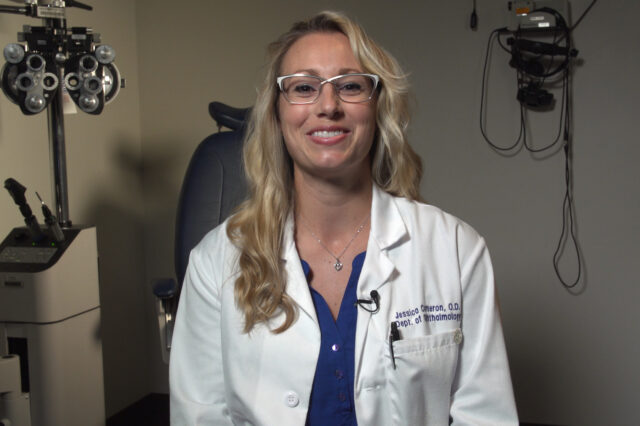How to protect your eyes while observing Monday’s solar eclipse

On Monday, many eyes will be on the skies above Gainesville during a partial solar eclipse. The eclipse will begin at 1:15 p.m. and peak at 2:47 p.m., obscuring 88 percent of the sun from view. Here are some ways to enjoy the event without jeopardizing your orbs.
“It’s important to not look directly at the sun during a solar eclipse because you can easily damage the cells that are important for 20/20 vision. The sun damage creates cell death and then you can lose your vision or even have blind spots that occur in the center of your vision,” said Jessica Cameron, O.D., a University of Florida Health optometrist and clinical faculty member in the UF College of Medicine’s department of ophthalmology. Sun damage can lead to blurry vision, which may improve after several months. Otherwise, the damage is likely to be permanent, Cameron said.
Cameron and other experts have these recommendations:
Get the proper eclipse-viewing glasses. The specs on your solar eclipse-viewing specs really do matter. The glasses can be bought online, but only a few companies make glasses that meet the ISO 12312-2 international standard. For a list of reputable sellers of solar glasses and viewers, visit the American Astronomical Society’s solar eclipse page at http://bit.ly/2uXMNP6. If your eclipse glasses are more than three years old, scratched or wrinkled, don’t use them.
Don’t cut corners. Your sunglasses may feel like the dark side of the moon, but they’re not suitable for viewing a solar eclipse. The same holds true for using tinted car windows, smoked glass, mirrors, medical X-ray films or the thick bottom of a beer bottle. A good rule of thumb: If it’s not a pair of approved eclipse-viewing glasses, don’t try it.
Consider a pinhole camera. If you don’t have proper glasses, try a pinhole camera. With just a few household items, it’s easy to take in the sun’s stellar show. The pinhole projects an image of the sun onto a screen made out of a sheet of paper, making for safe viewing. A NASA website has simple instructions for building the camera (https://go.nasa.gov/2qjJnnc).
Never use a camera, binoculars or a telescope without a special filter. Except during totality, when the sun is completely obscured by the moon, it’s never safe to look directly at the sun with these devices, according to the American Astronomical Society.
They magnify the sun’s light and heat, increasing the likelihood that the eye can sustain permanent damage. During partial phases of the eclipse, telescopes and other optical devices need to be fitted with a special-purpose solar filter.
Where to watch: The early weather forecast for Monday is 88 degrees with a 50 percent chance of scattered showers and thunderstorms. The UF department of astronomy is hosting a solar eclipse viewing event from 1 p.m. to 4:30 p.m. at the Campus Teaching Observatory on Sweetwater Drive. UF astronomers will be on hand with telescopes. A limited number of eclipse glasses will be shared among guests, and visitors are encouraged to bring their own glasses. Visitor parking is available at the J. Wayne Reitz Union, 686 Museum Road.
Eclipse questions and answers: UF experts will be on Facebook live answering eclipse-related questions at 1:30 p.m. Thursday, Aug. 17. The Facebook page for UF Research can be found at bit.ly/2i1BqB9.
About the author
